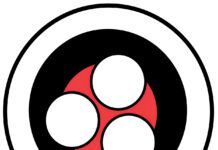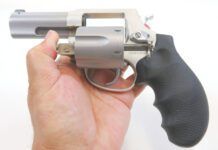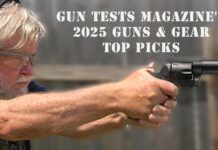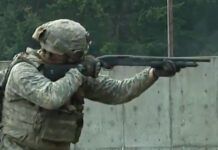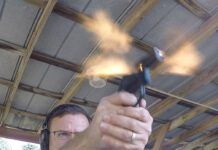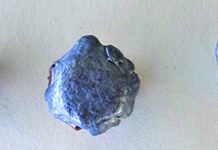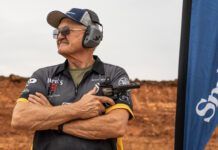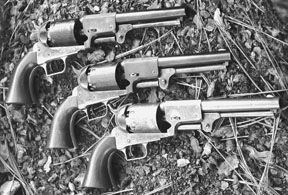
The Second Dragoon was the middle of three post-Walker revolvers developed by Colt beginning in 1848. All were designed for horseback use, and as such, weight was not much of a consideration, though at 4 pounds, the Dragoons weighed half a pound less than the Walker. There also was, most likely, ignorance about how heavy a revolver had to be in order to handle a given power level. For example, the 1860 Army Colt was not a lot less powerful than the Dragoon but weighed far less, yet was totally controllable, the result of ten years of refinement.
The Dragoon name comes from the use, or designated use, of this heavy pistol by the U.S. Mounted Rifles, some of which were called the Dragoons. Most originals, and all of our test trio, had the initials U.S.M.R. engraved on the cylinders. The Second Dragoon was in production from 1850-51, with a total of about 2,700 made. The First Dragoon was made from 1848 to 1850 in the quantity of about 7,000, and the Third Dragoon was made for about ten years, in the quantity of about 10,500. This makes the Second Dragoon the rarest of the original 4-pound Colts. In a similar manner, when Colt organized the production of the 2nd-Generation Dragoons in the early 1980s (built by Iver Johnson from I-J and Uberti parts), they made nearly 4,000 of the First, close to 7,000 of the Third, but only 2676 of the Second Dragoon, again rendering them the rarest of the lot. Easily distinguished by the square-back trigger guard and the rectangular bolt-stop notches, the Second Model Dragoon was originally presented with blued barrel, cylinder and trigger, and case-colored loading lever, hammer, and frame. The grip straps were brass, and grips were one-piece walnut. Some martial-use pistols had grips marked with an inspector’s escutcheon. Our test EMF has such a mark.
Original Dragoons (all three versions) designed for civilian sales had silver-plated grip straps. Elmer Keith had a rare cased example with silver-plated grips. For this test we gathered three Second Dragoons, one a 2nd-Generation Colt from 1981 (about $750), and two from Uberti, one imported by EMF and the other by Cimarron. The two more recent pistols were identically finished to begin with, but the EMF version has extra-cost acid-dip distressing, called “Old West” finish, that makes a new pistol look 150 years old ($370, or $300 with normal finish). Our test Cimarron ($349 as tested, or $389 with charcoal blue, or $399 with “Original” antiqued finish) had the normal blued and case-colored parts.
The distressing or antiquing makes the gun look just great to most eyes, but we take the greatest exception to the fact that the bores are not protected. The result is that you get an etched or slightly pitted barrel. How any company could permit the destruction of the bores is beyond our ken. One importer told us they’ve not had any complaints — until now. It would be the simplest matter to plug the bores and retain their integrity while at the same time aging the exterior. We strongly doubt anyone would complain if an old-looking gun had a perfect barrel. Our subsequent testing revealed that our opinion on this matter was indeed correct, as you shall see.
We prepared all three guns for easy cleanup by degreasing them and anointing the clean parts with Premium Lube from Eastern Maine Shooting Supplies, Inc. (www.emshootingsupplies.com/, phone: (207) 943-8808). This company has taken over the manufacture of the now-defunct Ox-Yoke Shooting Supplies products in near-identical form. Our former favorite product was Wonder Lube 1000 Plus, and the new Premium Lube works equally well. Eastern Maine Shooting Supplies is run by former employees of Ox Yoke. The use of their products made shooting and cleaning these guns a snap, with none of the mess nor constant wiping needed along the way.
We with GOEX FFg, KIK FFFg; with Triple-Seven from Hodgdon; and with Pyrodex P. In a nutshell, we liked real black powder best, but Triple-Seven gave much-increased velocity. Velocity was also up with Pyrodex P, but it had questionable ignition resulting in many slight hangfires, and we do not recommend it. All three guns shot about 7 inches high, common for the genre. The rear sight is the hammer, and it can be ground a bit to give a wider notch and lower impact, but there’s little need for that unless you plan to use the gun seriously. We found a lack of uniformity in the nipple size on the two Ubertis, which both took #10 caps. We had to use a knife to seat some of the caps, which is never fun. We put all three Dragoons to the test, so follow us now, back to the Western frontier.
The look and feel of this gun was excellent, particularly in the quality of the bluing and case coloring. They were superior to those of the Cimarron. Cimarron offers charcoal bluing as an option and it might be as attractive as the Colt’s bluing, but the old case coloring would be hard to match, we thought. The Colt alone of the test guns had all the proper markings. On top of the barrel flat was “ADDRESS SAML COLT NEW-YORK CITY”. On the left side of the frame in front of the trigger guard was “COLTS PATENT” in two lines. On the cylinder was “MODEL U.S.M.R.”, the serial number, and “COLT’S PATENT.” All three guns had the identical scene by Ormsby depicting an engagement between mounted Dragoons and a band of Indians. This Colt had the serial number on the cylinder, frame, barrel, grip strap, and the last four digits on the bottom of the grip. The serial number was also given in full on the barrel key, though the key number was one digit off from the remainder.
The condition of our test gun was close to new, though it bore a few marks from service and storage over the years. The quality of the one-piece walnut was a notch above the others, we thought. The brass straps showed some age yellowing. The nipples had been turned to accept #11 caps, the original size having been for #12s, which are no longer available. We were informed the latch had also been modified to keep it shut. It originally had a weak spring and, like both the newer guns, had incorrect angles on its engaging surfaces, which caused it to open with each shot. The engaging surfaces of the Colt were now parallel to the barrel and the spring was quite stout. It never came open for us, alone of all three test guns. Both of the others required closing the latch after nearly every shot.
The hammer did not have a roller where it engaged with the hammer spring. This, from our research, was incorrect. The two new Ubertis had hammer rollers. This Colt had the correct short curved trigger, but we found it to be less comfortable than the others. The two new guns had the Third Dragoon’s longer and straighter trigger shape. One big difference was that this 2nd-Generation Colt had more room to get a cap onto the nipple. The newer guns had smaller frame cuts. The hammer of the Colt had a hole, which engaged the safety pins of the cylinder. The newer Ubertis had a notch. We don’t know which is correct, but both systems worked well, which permitted us to load all six chambers.
The timing and lockup was excellent, but was excellent for all three guns. We tried interchanging barrels and cylinders, and they all would go wherever we wanted to put them. We loaded all three guns identically. We used a volume measure that threw 50 grains of FFg GOEX, and always used that volume of whatever powder we tried. Most of our shooting was with real black powder, and the preparations we mentioned above with Premium Lube worked perfectly with real black. We loaded 50 grains by volume of powder, followed that with a thick lubricated wad (formerly Wonder Wads, now Premium Lube 100% “Wool” Wads from Eastern Maine Shooting Supply, Inc.), and then rammed a Speer 0.457-inch ball down on top of the wad. We used no over-ball grease, nor did we need it. We were able to shoot each gun as long as necessary with no need for periodic cleaning. We did clean between types of powder.
On the range, the Colt was disappointing. Our best groups were around 2.5 inches, and were fired with FFg GOEX. We were told the bore had been fire-lapped, and that this had improved its performance, but it still was not as good as we got with the Cimarron. We measured the chamber and groove diameters and found a huge discrepancy, the chambers being some 0.016 inch smaller than the grooves. This resulted in lots of blowby and poor accuracy. The Colt’s bore always looked dirtier than the others after the same amount of shooting. The solution, the owner told us, will be to enlarge the chamber outlets and get a custom ball mould.
[PDFCAP(3)]
The first problem with this gun is in the model name. Second Dragoons didn’t exist in 1848. It ought to be named the 1850 model, but we’re picking nits. The gun looked absolutely great with its aged finish. The near-white color made the gun look bigger than the others, and showed off the massive size of the Dragoon well. The one-piece walnut grip had an inspector’s cartouche, correct per our research sources for military-designated Dragoons. The hammer had the correct roller, as noted above. There were few markings on the EMF. The Colt name did not appear, nor did the EMF name. The serial number appeared on frame and barrel. Hidden beneath the loading lever were the words: “CAL 44 BLACK POWDER ONLY – A. UBERTI ITALY.”
After our first inspection we took the gun apart to prepare it, and found some potentially very serious rust spots. The screws had lots of it. If you buy one of these Ubertis with this old-style finish, which is achieved by acid dipping, we suggest you disassemble the whole gun, every part, and boil those which show rust. Then anoint them all with Premium Lube, or your personal choice of goo if you want to second-guess us. By the way, we make no claims that Premium Lube or the old Wonder Lube 1000 Plus will work with Pyrodex or Triple-Seven. We have tested extensively with real black powder, and both types of grease work well.
Our inspection showed the bore of the “aged” EMF (Cimarrons are “aged” the same way) had etching and small pits. Would it shoot? We really liked the old-gun look, and the absence of finish made the missing markings less obvious. No serious collector of old Colts will be fooled into thinking this is the real thing, not with the Uberti name beneath the barrel and sundry other clues. But at a glance it sure looks the part. Also, no one is going to take an original Dragoon worth well into five figures to a Cowboy Action match. These aged reproductions are fine guns for shooting and for display. So with shooting high on the list, why do the makers destroy the barrel?
Fitting was excellent, and the inner dimensions were as good as the Cimarron’s. The gun worked perfectly in all respects, and shooting was fun and easy, but as suspected from our inspection of the bore, accuracy was very poor. We didn’t know how poor it was until we tried the similar but undistressed Cimarron, which turned out to be the most accurate gun of this test. It regularly printed all six into 1.5 inches at 15 yards, dirty or clean, with FFg GOEX. The EMF shot groups of about 3.5 inches, with some close to 5 inches. Out of curiosity we tried a dozen fire-lapping rounds, using Neco’s 220-grit compound, and things picked up. Groups shrank to about 2.5 inches on average. Our fire-lap groups made almost one hole at 10 yards, so the gun clearly has potential. By the way, both the EMF and Cimarron had rifling twists nearly three times as fast as the 2nd-Gen. Colt. The new guns’ grooves were shallower, and the chamber outlets came within a couple of thousands of matching the groove diameter. This is why the Cimarron shot so well, and why we were so disappointed with the EMF’s — and the Colt’s — accuracy.
[PDFCAP(4)]
The finish was very nice on the Cimarron, though the Colt looked better than this one, side by side. For $40 more you can get charcoal bluing, or for $50 more you can get all the finish removed, and it’ll look about like the EMF. Because the bores are not protected during the aging process for both EMF and Cimarron, you might want to buy the nicely finished gun, shoot the dickens out of it, mistreat it for a century or so, and end up with one that looks just like the antique-finished one. But not many are that patient, or dedicated. The fit and finish of the Cimarron were excellent, on a par with the Colt and the EMF. As noted above, the inner dimensions were extremely good, and the bore looked like a mirror, so it was no surprise the gun shot well. All three felt very much the same in cocking and handling. The trigger pull of the Cimarron was okay, though not as nice as the EMF’s. It broke cleanly at 3 pounds. The Cimarron and EMF both lacked the cutout in the recoil face of the frame, just to the right of the hammer, which was designed to let the fired primer slip out of the gun. It didn’t seem to make much difference, but we did note the Colt seemed to get its primers out of the way a touch easier.
The Cimarron had a clever touch. On top of the barrel flat where the Colt had its address, this one had “ADDRESS CIMARRON FREDERICKSBURG TEXAS.” And like the EMF, it had the Uberti name and black powder line beneath the loading lever, the serial number on frame and barrel, and no other extra markings at all. The engraved cylinder was identical to the others. The gun was well fitted and tight, the wood finish was excellent, and the brass was nicely polished and bright. Again we wanted silver plate, and the individual owner can perhaps do that himself. The fit of the one-piece wood to the grip straps was again excellent.
Gun Tests Recommends
• Colt 2nd-Generation Second Dragoon, about $750. Conditional Buy. We liked this gun a lot because of its place in history and its perfect historical markings. The Colt name has magic. We were disappointed in its accuracy because of its poor dimensions, but it was probably more than adequate for most shooters. Some of the test crew thought the 2nd-Generation Colts probably ought not to be fired, to best preserve the gun’s value, and the value is indeed going up with time. However, others thought that any good gun ought to be shot. We concluded that the Colt 2nd-Gen. Second Dragoon was well worth owning, but if you simply want to shoot a Dragoon you’d probably be better off with one of the modern Ubertis for a lot less money, and would not harm its value by using it. It’s your call.
• EMF Model 1848 2nd Model Dragoon Revolver Reproduction, Antique Finish, $370. Conditional Buy. We loved the look of this gun, and would pick it over both the others if it shot well. It had the best trigger pull, right at 2 pounds with zero creep. The EMFs are a touch less costly than Cimarron’s, no matter which finish you choose. So you’ll save a bit with the EMF. We guess a lot of buyers won’t care how well the gun shoots, and will probably love the distressed finish more than we did. We commend EMF for offering this handgun. Not many makers provide much in the way of cap-and-ball handguns today, much less Dragoons. How long they’ll be available is anyone’s guess. So if you want a boomer, you may want to act soon. We’d buy this one, but would really like to know if it can be made to shoot well. We tried a bit more fire-lapping and just before press time shot five into 1.6 inches, but all six made a 3.6-inch group. Progress, but we’re not happy yet. This extra work really ought not to be necessary.
• Cimarron CA081 Second Model Dragoon, $349. Buy It. On the range the Cimarron distinguished itself very well. With FFg GOEX we made many tiny groups. Nothing else shot as well as that combination, and neither of the other two guns could match it.
We got impressive velocity out of Triple Seven, close to 1200 fps, but accuracy was not there. All in all, we liked this gun the best of the trio. At $350 it was the least costly of the group, though the EMF with this finish would run $300. Of the guns in this test, this is the one we liked the best. It ought to age gracefully, it looked fine as it was, and shot the best. We’d buy it.



